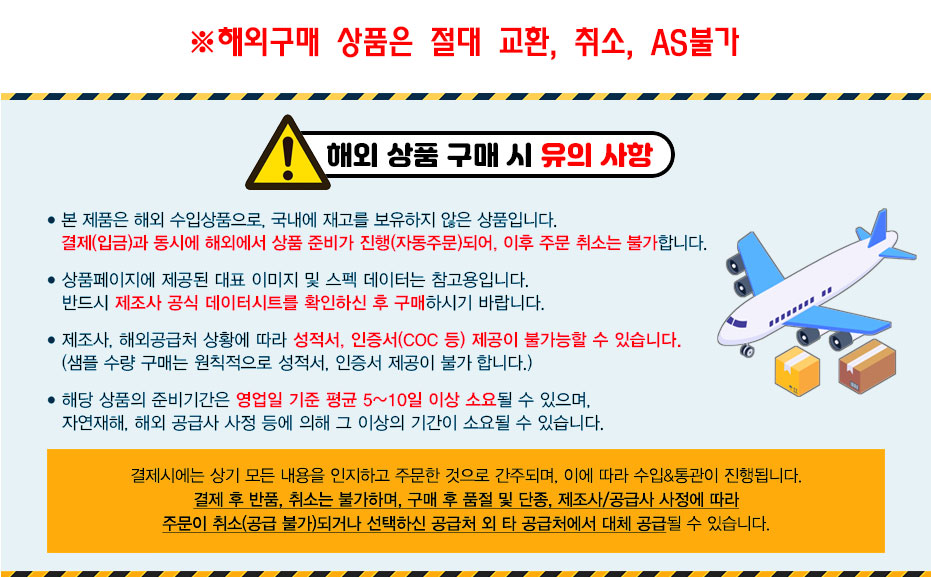
■ 제품필수정보
| 제조사 |
RS PRO |
| 제조사품명 |
DM-312 |
| 간략설명 |
RS PRO PT100 RTD Sensor, 1.2mm Dia, Chip, +500°C Max |
■ 제품사양
Sensor
타입 = PT100 Probe Diameter = 1.2mm Minimum Temperature Sensed = -50°C Maximum Temperature Sensed = +500°C Termination
타입 = Solder Process Connection = Chip RS Pro Thin Film Pt100 Platinum Resistance Temperature Detector. From RS Pro a high-quality and reliable Pt100 and Pt1000 PRT (Platinum Resistance Thermometer) or RTD (Resistance Temperature Detector). These temperature sensors have a thin film construction for accurate and reliable temperature measurement along with a fast response time to temperature changes. This design is also resistant to both vibration and shock. The flat design of these PRTs makes them ideal for measuring temperatures on surfaces. From RS Pro a range of high-quality and reliable Pt100 and Pt1000 precision platinum RTDs (Resistance Temperature Detector) also known as PRTs (platinum resistance thermometers) or PRT sensors. These Pt100 and Pt1000 temperature sensors have a thin film construction for accurate and reliable temperature measurement along with a fast response time to temperature changes. This design is also resistant to both vibration and shock. The flat design of these Pt100 and Pt1000 temperature sensors mean that they are ideal for measuring temperatures on surfaces What is a Pt100/Pt1000 RTD? An RTD is a type of temperature sensor based on the correlation between metals and temperature. As the temperature of a metal increases so does it's resistance to the flow of electricity. This resistance can be measured and converted to a temperature reading. ??Pt ??stands for platinum (platinum wire or film) and ??00 ??means the temperature sensor has a resistance of 100 Ohm at 0°C and '1000' means it has a reistance of 1000 Ohm at 0°C. Platinum is the most reliable metal due to it's linear resistance to temperature relationship over a large temperature range. What is a Thin Film RTD? A thin film platinum RTD consists of a thin layer of platinum (usually 1 micron thick) on a ceramic substrate. This is then covered with a layer of epoxy or glass for protection against high voltages and to maintain a high insulation resistance. The thin layer of platinum results in the sensor having a high resistivity and fast response times to changes in temperature. Thin film RTD elements are sometimes incorporated into protective housings or other types of assembly allowing them to be used in harsh conditions Accuracy Classes The accuracy classes for the tolerances of these platinum resistance thermometers are defined in the IEC 60751 standard and are as follows: Class A = ± (0.15°C + 0.2%) Class B = ± (0.3°C + 0.5%) 1/3 DIN = ± (0.1°C + 0.5%) 1/10 DIN = ± (0.03°C + 0.5%) Features and Benefits Thin film construction High stability and accurate output Linear output over a wide operating range A fast thermal response time of 0.1s Resistant to vibration and shock Measures temperature ranges from -50 to +500°C 10 mm lead wires Applications These thin film Pt100 and Pt1000 temperature sensors are suitable for surface and immersion applications where protected. Their flat design means they offer a minimally intrusive means of measuring temperatures on flat surfaces. Applications and industries include the following: Automotive industry Chemical industry Micro-electronics Air conditioning and refrigeration Air, gas and liquid temperature measurement Food processing Laboratories Questions and Answers How Does a Pt100/Pt1000 RTD Work? The Pt100 and Pt1000 sensor works by placing the sensor element (or process end) into the equipment or process that requires temperature measurement. As the temperature of the platinum resistor increases it ??s resistance to the flow of electricity increases. For every increase per degree of temperature, the electrical resistance of the sensor element increases linearly by 0.385 Ohms. This is called the temperature coefficient. The total resistance reading can, therefore, be measured and converted into temperature. How is the Resistance Measured? The resistance generated by the Pt100 or Pt1000 RTD is measured by passing current through one of the wires to produce a voltage. This voltage is then measured using a suitable bridge or voltmeter and the resistance calculated in ohms using Ohm ??s Law (R=V/I). Once the resistance known you can convert it to a temperature reading using a calibration equation or a Pt100/Pt1000 table. A temperature measurement device or calibrator can also be connected to the sensor that will automatically convert the measured resistance into a temperature reading. What is a Pt100/Pt1000 RTD?. An RTD is a type of temperature sensor based on the correlation between metals and temperature. As the temperature of a metal increases so does it's resistance to the flow of electricity. This resistance can be measured and converted to a temperature reading. ??Pt ??stands for platinum (platinum wire or film) and ??00 ??means the temperature sensor has a resistance of 100 Ohms at 0°C and '1000' means it has a reistance of 1000 Ohms at 0°C. Platinum is the most reliable metal due to it's linear resistance to temperature relationship over a large temperature range. What is a Thin Film RTD?. A thin film platinum RTD consists of a thin layer of platinum (usually 1 micron thick) on a ceramic substrate. This is then covered with a layer of epoxy or glass for protection against high voltages and to maintain a high insulation resistance. The thin layer of platinum results in the sensor having a high resistivity and fast response times to changes in temperature. Thin film RTD elements are sometimes incorporated into protective housings or other types of assembly allowing them to be used in harsh conditions. Features and Benefits. Thin film construction High stability and accurate output Linear output over a wide operating range A fast thermal response time of 0.1s Resistant to vibration and shock Temperature measurement range from -50 to +500°C 10 mm lead wires. Applications. These thin film PRT temperature sensors are suitable for surface and immersion applications where protected. Their flat design means they offer a minimally intrusive means of measuring temperatures on flat surfaces. Applications include the following:. Automotive industry Chemical industry Micro-electronics Air conditioning and refrigeration Air, gas and liquid temperature measurement Food processing Laboratories. Frequently Asked Questions. How Does a PRT Temperature Sensor Work?. The PRT temperature sensor works by placing the sensor element (or process end) into the equipment or process that requires temperature measurement. As the temperature of the platinum resistance thermometer increases it ??s resistance to the flow of electricity increases. For every increase per degree of temperature the electrical resistance also changes by a set ratio, this is called the temperature coefficient. For platinum, this ratio is .00385 ohm/ohm/°C which means for a Pt100 with a 100 ohm resistance the increase in resistance per degree of temperature would be 0.385 ohms. The total resistance reading can, therefore, be measured and converted into temperature. How is the Resistance Measured?. The resistance generated by the Pt100 or Pt1000 RTD is measured by passing current through one of the wires to produce a voltage. This voltage is then measured using a suitable bridge or voltmeter and the resistance calculated in ohms using Ohm ??s Law (R=V/I). Once the resistance known you can convert it to a temperature reading using a calibration equation or a Pt100/Pt1000 table. A temperature measurement device or calibrator can also be connected to the sensor that will automatically convert the measured resistance into a temperature reading





